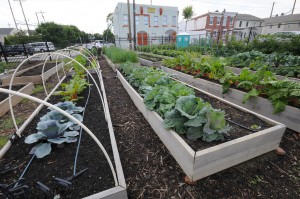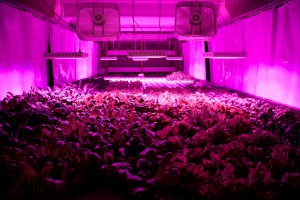Never before have this many people lived on our planet at the same time. When the official UN estimates of the world population crossed the magical line of 7 billion in October 2011, the reactions of the press ranged from attempts at giving their readers a possibility to calculate their own number to bringing up common problems of the perceived overpopulation and future challenges. Amongst the most commonly mentioned subjects of concern were poverty and hunger.
 In order to provide for mankind, new technologies in agriculture are in dire need. In the world’s most populous areas, urbanisation takes ever bigger forms, while cultivation areas are either in decline or can only grow through the destruction of nature. At the same time, a lot of consumers in more developed countries would prefer locally grown products to products that have been shipped around half the world before reaching the supermarket aisles. So why not integrate agriculture into our towns and cities? A lot of efforts have been made in the past few years, such as municipal volunteer projects using the parks and gardens of towns for growing food or the boom of architectural visions incorporating nature, be it in the form of rooftop gardens or garden beds on platforms protruding from the side of buildings.
In order to provide for mankind, new technologies in agriculture are in dire need. In the world’s most populous areas, urbanisation takes ever bigger forms, while cultivation areas are either in decline or can only grow through the destruction of nature. At the same time, a lot of consumers in more developed countries would prefer locally grown products to products that have been shipped around half the world before reaching the supermarket aisles. So why not integrate agriculture into our towns and cities? A lot of efforts have been made in the past few years, such as municipal volunteer projects using the parks and gardens of towns for growing food or the boom of architectural visions incorporating nature, be it in the form of rooftop gardens or garden beds on platforms protruding from the side of buildings.
The most promising idea, however, seems to be vertical farming, a technique where plants are grown on rack units with integrated LEDs, stacked all the way to the roof of a building, taking production to an industrial scale. The world’s largest factory of this type is currently located in Tagajo, Japan, owned by Mirai Inc., a company specialising in indoor farming. An old Sony factory, abandoned after the Earthquake in 2011, serves as the prototype facility. At the moment, it produces about 10,000 heads of lettuce a day on a floor space of only about 2,300 m², which is not even half the size of the football field at the Olympic stadium in Munich, with up to 15 rows of cultivation units stacked on top of each other.
The special LED lights used in the racks have been optimised to emit only wavelengths that promote plant growth, which helps both saving energy and reducing the time a plant needs to grow before being harvested. In fact, the usage of artificial lighting allows to shorten the day and night cycles of the plants.
 As the factory is more or less a closed system, the lettuce grown in the building only requires about one percent of the water commonly used for growing lettuce, as water can be collected and reused. At the same time, it is now nearly impossible for pests to infest the plants thanks to the controlled environment and the strict hygiene guidelines. This means that at the Tagajo facility, pesticides have been made redundant, resulting in the products leaving the factory being more healthy than conventional ones. Another advantage of this type of farming is that it can be integrated into existing structures, such as the empty shells of old factories. Moreover, the percentage of lettuce that is thrown away before it even reaches the supermarket has been cut down to 3%, wheras 30% to 40% is the norm in conventional farming.
As the factory is more or less a closed system, the lettuce grown in the building only requires about one percent of the water commonly used for growing lettuce, as water can be collected and reused. At the same time, it is now nearly impossible for pests to infest the plants thanks to the controlled environment and the strict hygiene guidelines. This means that at the Tagajo facility, pesticides have been made redundant, resulting in the products leaving the factory being more healthy than conventional ones. Another advantage of this type of farming is that it can be integrated into existing structures, such as the empty shells of old factories. Moreover, the percentage of lettuce that is thrown away before it even reaches the supermarket has been cut down to 3%, wheras 30% to 40% is the norm in conventional farming.
To further improve the process, sensors are being employed to measure factors such as temperature and air moisture, upon which airflow, irrigation and lighting are adjusted. This also allows for improvements to the software used in the control systems of the factory.
However, this type of farming still has quite a few limits. While large parts of the growing process are already automated, a lot of things still need to be done by hand. What’s more, the factories are highly dependent on a good internet infrastructure for their control systems and a steady supply with energy and water. Some of these problems could be overcome with the development of special harvest robots and the ever growing renewable energy sector. The initial costs to set up a sizeable facility, which are higher than for conventional farming, are easily paid off in time due to the higher efficiency of these farms. By experimenting, other types of plants, such as tomatoes and cucumbers, could soon be added to the range of products. Additionally, the technology could not only be used to relieve some of the hunger in the world, but also to grow medicinal herbs.
The concept has already yielded promising results: Similar factories (of various sizes) have been constructed in several locations in Japan and Mongolia. Additional factories are due to be built in Russia and Hong Kong. Japan has traditionally only very limited surface area available for farming and seeks new incentives for economic growth, following the devastation caused by the 2011 earthquake and tsunami. Hong Kong and Mongolia want to become more independent in terms of food. Mongolia, however, is not limited by space like Hong Kong, but rather by the harsh climate which makes farming impossible. Consequently, despite the vast differences between the countries that have ordered factories to be built, vertical farming can be a solution for all of them due to its unique properties.
However, due to its heavy reliance on a good infrastructure, it might take a while until vertical farming becomes feasible in Third World countries. This means that more efforts have to be made to improve the existing production capacities by employing scientific farming methods. It is a race against time. Not only does the world’s population continue to grow, but there are already 805 million people currently suffering from hunger today, according to current estimates. Amongst them, there are many children – about 100 million of children in developing countries are underweight and about half of the deaths in children under the age of five are caused by hunger, killing about 3.1 million children each year.
Humanity should not pin all its hopes on vertical farming. The existing farming technologies have made huge jumps since the digitalisation. Therefore, it is not unlikely that we will see autonomous tractors, harvesting machines and picking robots supported by satellite pictures and drones equipped with new types of sensors in the future. Nonetheless, we need to do our bit to change consumer behaviour first, which might lead to a more fair distribution of food in the world.
By Michael Schätzlein
Image credit:
Picture 1: TCDavis, licensed under CC BY-NC-ND 2.0
Picture 2: Plant Chicago, licensed under CC BY-NC-ND 2.0









